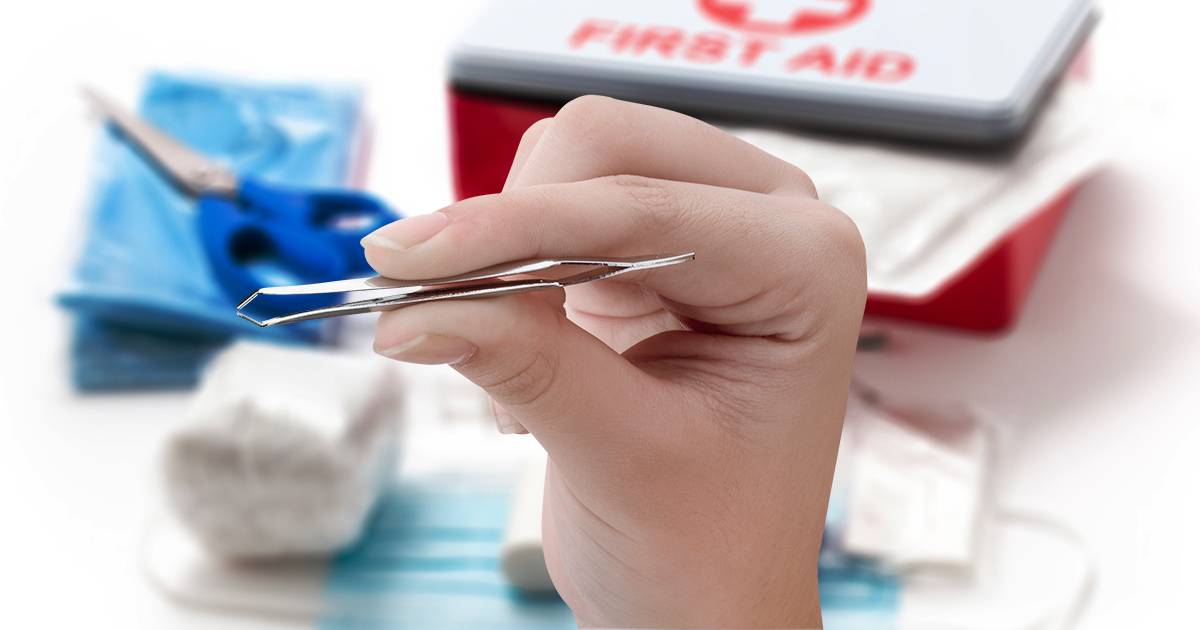How Tweezers Are Used in First Aid and It’s Alternatives

In times of unexpected accidents or injuries, a well-stocked first aid kit can serve as a lifeline, offering the tools needed to provide immediate care. Within this compact arsenal, items like bandages, antiseptics, and gloves often take center stage. However, one inconspicuous yet indispensable tool that deserves attention is the humble pair of tweezers. In this article, we delve into what would tweezers be used for in a first-aid kit. We will also explore alternative tools to consider when faced with a splinter, foreign object, or similar minor emergency.
Why Have Tweezers in Your First Aid Kit?
Within the compact confines of a first aid kit, tweezers might appear unassuming, but their value becomes glaringly evident when confronted with situations that necessitate the careful extraction of splinters, thorns, or foreign objects lodged in the skin. Unlike our fingers, tweezers provide a controlled grip that significantly reduces the risk of unintentionally pushing objects deeper into the skin. The precision they offer ensures that the foreign object can be swiftly and accurately removed, minimizing tissue damage and pain.
Tweezers are particularly indispensable in scenarios involving the removal of ticks or insect stingers. Swift and proper removal of these intruders is crucial in preventing further discomfort and the potential for infection. While our natural reaction might be to pinch or scratch these irritants, this approach often exacerbates the situation by breaking off the stinger or pushing the tick’s head further into the skin. Tweezers, with their fine-tipped precision, allow for a gentle and efficient extraction, mitigating the associated risks.
By including tweezers in your first aid kit, you ensure that you are adequately equipped to address a diverse range of minor emergencies. From splinters acquired during outdoor activities to insect stings in remote locations, tweezers offer a versatile solution that enhances the quality of immediate care and reduces the likelihood of complications.
What Are Tweezers Used for in a First Aid Kit?
The versatility of tweezers within the realm of first aid is truly remarkable. Their primary role involves the safe and precise removal of splinters, shards of glass, or debris that may have become embedded in the skin. While these intrusions may seem minor, they can cause significant discomfort and pose an increased risk of infection if not addressed promptly. Tweezers, with their fine and controlled grip, ensure that these objects can be extracted without causing further harm or complications.
Furthermore, tweezers serve as adept manipulators of bandages and dressings. Their precision makes them invaluable when applying and adjusting these essential components of wound care. Whether you are dealing with a minor cut, scrape, or more extensive injury, tweezers aid in the careful positioning of bandages to maximize their efficacy in protecting wounds from contamination.
In situations involving insect bites or stings, tweezers take on a pivotal role. They facilitate the delicate and efficient removal of stingers or venomous spines, preventing the injection of further toxins into the body. Timely and proper removal minimizes discomfort and the potential for allergic reactions, ensuring a smoother recovery process.
In essence, tweezers are an indispensable tool for managing an array of potential injuries. Their inclusion in the first aid kit empowers individuals to provide effective immediate care, ultimately contributing to better outcomes and reduced complications.
What Are the Alternatives to Tweezers?
While tweezers are a cornerstone of every well-stocked first aid kit, situations may arise where they are not readily available. In such cases, resourcefulness becomes essential, and alternative methods can effectively serve the same purpose:
1. Baking Soda Paste
A paste created from a combination of baking soda and water offers an alternative method for drawing splinters closer to the skin’s surface. By applying the paste to the affected area and covering it with a bandage for approximately 24 hours, the splinter may become more accessible for removal with alternative tools like needles or tweezers.
2. Banana Peels or Potato Slices
Leveraging the enzymes found in banana peels or slices of potatoes can be an unconventional yet potentially effective method for splinter removal. By placing a slice of banana peel or potato over the affected area and leaving it on for several hours, you may soften the skin and encourage the splinter to move closer to the surface, making removal easier.
3. Glue Method
Everyday glue, like Elmer’s glue, can play a surprising role in splinter removal. Applying glue to the skin around the splinter, allowing it to dry thoroughly, and then peeling it off gently can bring the splinter to the surface. This method is particularly effective for small, superficial splinters.
4. Hydrogen Peroxide or Vinegar
Common household items like hydrogen peroxide or white vinegar can aid in the removal of splinters. Pouring a small amount of either liquid over the affected area can trigger a bubbling effect that brings the splinter closer to the surface, facilitating easier removal with alternative tools.
5. Epsom Salt Soak
Epsom salt, often utilized for muscle relief, can also assist in drawing deep splinters to the skin’s surface. A warm bath infused with Epsom salt or an Epsom salt-soaked bandage pad can contribute to making the splinter more accessible for removal.
6. Duct Tape Method
Sticky tape, like sturdy duct tape, can be repurposed for removing shallow splinters. Applying tape over the splinter and leaving it on for around 30 minutes allows the adhesive to secure the splinter’s end. Gently peeling off the tape in the opposite direction of entry can effectively pull out the splinter, providing a simple and painless solution.
Bottom Line
Tweezers stand as an essential tool in the world of first aid, serving as a reliable instrument for addressing splinters, foreign objects, and minor emergencies. Their precision and grip ensure safe removal and prevent complications. While tweezers take center stage, the world of first aid provides innovative alternatives. Sticky tape, baking soda paste, glue, peroxide, Epsom salts, and everyday items like banana peels or potato slices all offer effective solutions when tweezers are not at hand. By understanding these diverse tools, we equip ourselves to respond effectively to unexpected situations, promoting well-being and safety.

